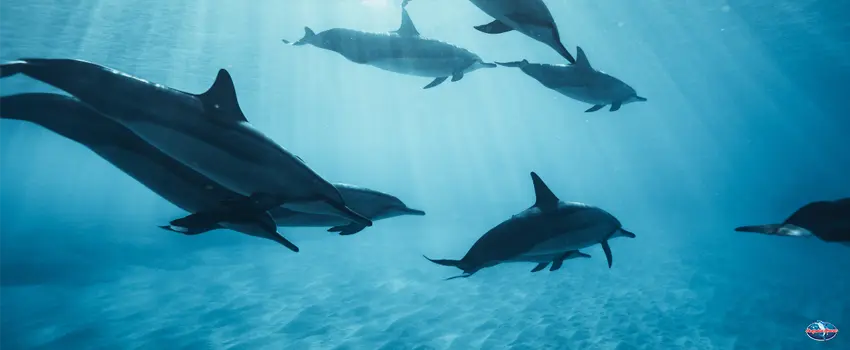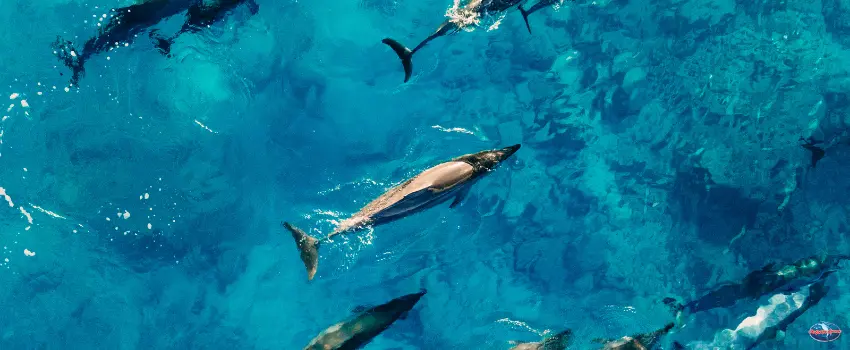The majestic dolphin is cute, playful, and charming. Catching a glimpse of the creature as it leaps from the water often tops the list of memorable moments from a vacation. To maintain its energy, a dolphin needs food. For a pod, hunting and foraging are important duties dolled out to specific members. More often than not, those chosen to hunt are female dolphins.
Hunting and foraging are often seen as male hobbies. In the animal kingdom, this is not always the case. On land, female lions supply most of the food for the pride, while the dolphin’s cousin, the orca, is a female-hunting species as well. Female dolphins use their wild and unique techniques to supply their pod with food throughout the year.
Hunting and Gathering
The bottlenose dolphin is the most common species in Tampa Bay and the Gulf of Mexico. A group of dolphins is a “pod.” A pod can be made up of several or even hundreds of dolphins. Male dolphins are known as “bulls” and female dolphins are called “cows.” To feed the pod, all dolphins work together to capture their prey.
A dolphin’s diet consists of many species of fish as well as squid, octopus, and shrimp. A dolphin uses its speed and agility to capture even its quickest prey. To do so, dolphins must act in tandem to capture their prey and have developed their own dolphin hunting techniques.
The most common way of capturing food is to create a bait ball. A bait ball is created when the dolphins herd fish into a large, compact ball and take turns diving into it. A bait ball makes for a beautiful sight in the water but is probably a terrifying experience for the fish. Off the coast of South Carolina, dolphin hunting behavior involves beaching fish. Working together as always, the dolphins will create pressure waves that drive the fish toward shore. Dolphins then snatch the fish while keeping at a safe distance, lest they themselves become stranded.
These methods are unique to dolphins around the world, many of whom have their own methods to handle the prey in their hunting ground. Female dolphins often spearhead these efforts.
Tools of the Trade
Facts about dolphins are ripe with interesting tidbits, most to do with their cuteness. When a dolphin is set on finding food, however, their ferocity shows. Finding food is different for an animal than it is for humans. Dolphins must hunt to survive, whereas we can pop into the neighborhood shop for a snack whenever we please. Female dolphins often lead these hunts and have developed interesting methods to capture prey around the world.
In Australia, the females of the species have formed a unique method to hunt hidden prey. The dolphins will use natural sponges as nose protectors to dig into the sandy bottom. There, they disturb hiding fish. When the fish bolts, the dolphin’s superior speed makes quick work of it. This behavior is notable for being a female habit, as the bulls do not participate in this type of hunting.
Using tools for hunting and otherwise is a trait of dolphins that has been observed around the world. Female dolphins tend to learn to use the tools and then pass the habit down to their daughters. The sponge-wearing dolphins of Australia will show their babies, known as calves, how to use the sponges to gather sweet, sweet fish. Notably, males do not do this for unknown reasons.
Well-Oiled Fishing Machines
In the 1984 film The Terminator, John Connor explains that the killing machine from the future “doesn’t feel pity, or remorse, or fear, and it absolutely will not stop, ever!” Oddly enough, this quote can be used to describe dolphins as well. A study from the National Marine Mammal Foundation found that dolphins can stay alert for up to two weeks without sleep. Given that most humans lose focus without coffee in the morning, this is an impressive feat, one that gives them an edge when hunting.
Facts about dolphins extend to interesting corners of the dolphin universe, including ways to defend themselves. A dolphin’s top speed can reach up to 20 miles per hour. If a wayward shark finds itself in the wrong place at the wrong time, a dolphin – female or male – can brutalize it using its bony snout. Propelling itself at its enemy, the dolphin’s nose does as much damage as a shotgun blast would to humans.
Using this concept of utter overkill, female dolphins have found ways to hunt for larger prey as well. For a dolphin, sardines, squid, and shellfish are all small enough to chew. Large prey needs to be broken up into pieces to consume. Without thumbs, using a fork and knife is out of the question. So, how did female dolphins figure out how to eat such large prey? By slamming them against hard surfaces until they explode into tiny, bite-sized morsels.
To get the prey out of the water, the dolphin uses a technique known as punting. It’s exactly as it sounds: the dolphin will use its strong tail to hit the creature hard enough that it will fly from the water. Dizzied (or dead), the prey will then be easy pickings and sometimes eviscerated by the force.
Other times, dolphins will drag the prey along the sea floor until it’s ripped to shreds. They even have a method by which to eat spiny fish: gently pulling them apart like string cheese.
This begs the question: are female dolphins dangerous? If you are a fish, yes. If you are a human, maybe! All dolphins like to play and are, after all, wild animals. They have been known to play roughly with humans (and all manner of creatures). Regardless of sex, it’s best to be careful around them. Their cuteness can hide malicious intent!
Girl Power!
Getting an up close and personal view of dolphins in their natural habitat cannot be beaten. Experiencing the majesty of a pod playing peacefully in its natural habitat makes for lifetime memories. Get your fill of dolphin sightings aboard the Dolphin Quest, with tours departing daily from St. Petersburg, Florida. For more information, visit www.boattoursjohnspass.com.










